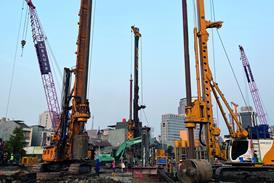You can cut crime and vandalism and make a tidy profit on the way.
There’s no point having gleaming new homes or refurbishing properties with ultra-modern kitchens and bathrooms if tenants are frightened by having to walk past a dilapidated line of garages every time they go out.
That’s the thinking behind arm’s-length manager Hounslow Homes’ efforts to renovate or demolish the 2800 garages that are in disrepair across the west London borough. Graham Edwards, the ALMO’s garage business manager, says Hounslow’s 40-year-old garages had become low priority because no one had overall responsibility for them. “The garage service had been left to wither on a branch,” he says.
The garages had become blighted by vandalism, decay, fly-tipping and antisocial behaviour. To sort them out, Edwards decided to refocus attention on the garages service with the aim not only to clean up the garages, but to bring in revenue as well. “We analysed what our income and costs were and drew up a business plan,” he says.
To do a similar overhaul, the first thing to do is make sure you know where your garages are. Hounslow council had no up-to-date records of how many it owned or their condition, so Edwards commissioned a survey of all stock, at a cost of £15,000. This identified 167 sites in the borough, with 2800 units. And despite Hounslow being in prime commuterland, 750 were unused.
The findings revealed a mixed picture: in the more suburban areas, there was plenty of free parking, leading to lower demand for garages, which were falling into dereliction. In more urban areas, there was massive demand. But one problem affected garages across the borough: many were built in “batteries” of 20-30 units facing each other, creating crime-friendly enclosed areas.
“People told us they wouldn’t go down there at night on their own,” says Edwards.
Once you know the problems, you can decide what to do. It might be a good idea, for example, to demolish one half of a battery of garages to create more space and make users feel safer. If you’re considering demolition, see if council planners want to use sites for other purposes, such as more houses. “A large proportion of our void sites would be valuable land banks for the council,” says Edwards.
In built-up areas, however, a tidy profit could be made from people desperate for parking space if the garages are in good condition. “In Feltham, we could let all our units three times over,” says Edwards.
The borough has just finished work at the Northfields Estate, which had 39 garage units, of which 19 were empty. This site is near a school and pupils were vandalising the site, so the council put up a 2 m steel fence and made the school headteacher aware of the problem.
It was also a fly-tipping spot, so the council is installing a vehicle barrier that only garage users will be able to raise. Lights have been put in for the first time and old asbestos panels removed from the roofs.
Once you’ve cleaned up your stock, think about how much you charge for its use.
Hounslow hopes to vary rents according to whether they are let to private or council tenants. “We used to charge £10.67 a week, but there are some private garages off the high street in Chiswick that estate agents rent out for £20-£25 a week,” Edwards says.
Council tenants will get priority, and local estate agents will manage letting the leftover units to private residents. In less popular areas, lower rent could bring them back into use, helping to reduce vandalism.
Hounslow council considered setting up a separate garage services team, but the cost proved to be prohibitive. Instead, Edwards has re-emphasised to housing teams the need to care for the garages: employees in each area should spend the equivalent of four days a month just managing the garages, he says.
Hounslow’s three-year programme of repairs and demolition will cost £200,000 a year and Edwards expects the total cost of running the service and keeping it in good repair to be about £500,000 a year.
This will easily be funded by rental revenue, he adds. Hounslow’s garage income was £810,000 last year, but it is hoping to increase this to £1m by the end of the programme, leaving them with about £500,000 profit a year.
“We have created a significant small business and still have a land bank that in the future could be used to deliver social housing,” says Edwards.
Source
Housing Today

















No comments yet